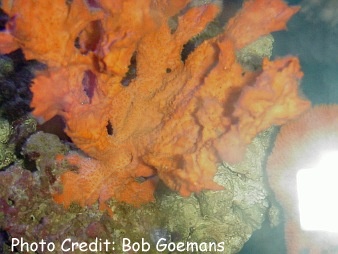
By Bob Goemans

Likely Reef Tank Suitable
Likely Fish-Only Tank Suitable
Range: Western Atlantic Ocean: Florida, Caribbean and the Bahamas.
Natural Environment: Inhabits shallow and deep waters in calm clear environments.
General Husbandry: Occasionally seen in the tropical home aquarium trade.
This is a non-photosynthetic filter-feeding animal and requires shaded areas receiving excellent water movement. Requires at least one daily feeding of live and/or preserved commercial phytoplankton and zooplankton products, or that of animal and plant powders that produce suspended products in the bulk water. Even though it prefers somewhat nutrient rich surroundings, it will not tolerate alga growth.
Generally, almost all sponges are difficult to maintain long term in captivity without special attention to their individual needs. Should be kept in systems designed to meet its needs, not simply as an addition to a new reef tank or even that of a thriving reef system if its nutritional needs cannot be met.
Occasionally stirring of the substrate/sediment/sandbed will also help small particulate matter (detritus) to enter the aquarium's bulk water, somewhat helping to provide some nourishment.
Unfortunately heavy feeding sometimes results in unwanted algae growths, therefore, increase filtration measures should be taken shortly after feedings if wanting to maintain most sponges in a healthy condition.
Taxonomy:
Kingdom: Animalia
Phylum: Porifera
Class: Demospongiae
Subclass: Heteroscleromorpha
Order: Agelasida
Family: Agelasidae
Genus: Agelas
FYI: When purchasing new specimens, they should be bagged under water, i.e., never lifted out of the water. Nor should any air or oxygen be added to the bag, as it may become trapped in the animal's tissue while being transported and lead to its early demise.
They are not too sensitive to temperature changes, yet sudden changes in salinity may have drastic effects.
New specimens should not contain any gray or white tissue, which is generally a sign of dying or dead tissue. However, it is possible to cut that section out, of course under water.
Experience Level: Intermediate
Diet: Filter feeder
Aquarium Environment: Reef or fish-only aquarium
Coral Safe: Yes
Fish Safe: Yes
Invertebrate Safe: Yes
Acclimation Time: Sensitive to specific gravity/salinity changes, therefore be sure to adjust the bag's water to that of the aquarium in which it will be placed by slowly adding small amounts of aquarium water to the bag every few minutes. In most cases, this process should take at least 15 minutes.
Aquarium Hardiness: Challenging
Temperature Range: 72 - 83°F (22 - 28°C)
Minimum Tank Size: 50 gallons
Water Movement: WM 1 - 2
Specific Gravity: 1.023 - 1.025
pH: 8.0 - 8.4

.jpg)